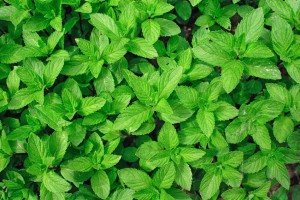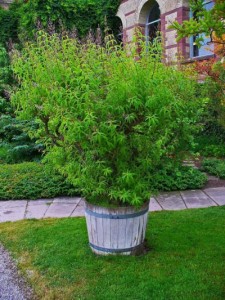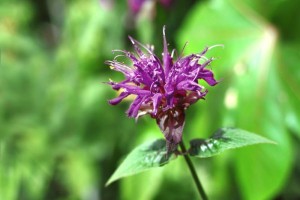On these hot dog days of summer all I want to think about is a tall glass of refreshing herbal tea over ice. I dream of having a tea garden with thriving, deep green plants that I can walk between and harvest from at all hours of the day, all year long.
But we’ve all got to start somewhere. Let me tell you about the some of my favorite tea garden herbs. But first, a few general notes on growing herbs. Your tea garden herbs have many of the same requirements as your vegetable garden, and many of them can be grown in pots on patios, inside on a sunny windowsill, or in raised beds just as easily as outside in the ground. Some herbs such as annual basils will thrive in summer’s heat while others, like mint, will appreciate the cooler seasons, but will keep growing through summer if adequately watered. Just like vegetables, each herb will have its own specific set of favored conditions.
Cinnamon, Aromatto, and Lemon Basil
I’m quite fond of basil, and can be found growing about three different types at any one time. As we know, basil is a hot weather crop, often coming at the same time as summer’s tomatoes (mother earth works in mysterious and delicious ways!). It’s an easy one to start from seed. Basil in general isn’t too picky – as long as you’ve done your work to prep your soil, you can sow basil in late spring, tuck it into the ground a month or 6 weeks later, and wait for it to be big enough to start picking leaves off, or until there are leafy stems about 4” or longer that you can cut, bundle, and hang to dry. If your main use for these herbs is tea, continue to pinch the stems off and dry them throughout the season so that they don’t burst into flower.

These beauties came into my life as I began growing flowers for bouquets. I can’t recommend these basils highly enough for use as greenery in mixed bouquets. The scents are intoxicating and their gorgeous to look at. They demand similar growing practices as pesto basil – but in this case you don’t want to pinch the tips – you want to let them flower! Wait until the stems are quite stiff and the flowers are fairly well developed to pick long stems for bouquets. They wilt quickly and easily, so you’ll want to cut first thing in the morning before it’s hot out.
Tulsi Basil
Many people out there have tried tulsi tea out of a box, but don’t associate it with the beautiful, easy-to-grow plant it comes from. Tulsi or ‘Holy’ Basil plays an important role in Ayurvedic medicine, in Hinduism, and, often, in Thai cooking. It is believed that the plant helps sharpen memory along with a whole range of other health benefits. It’s a winner and a staple for tea garden herbs.
Tulsi basil grows as an annual in our climate just as easily as pesto basil does. Plant it in a sunny spot in the garden from May – July, and give it plenty of water. Harvest short stems of leaves as they come on and hang to dry. Much like lemon verbena, Tulsi basil is delicious as a simple tea with hot water and honey.
Mint
I’m a mint junkie. I have a garden at home with about seven kinds of mint and counting – orange bergamot mint, pineapple mint, mojito mint, apple mint, some unidentified mint dug up from a friend’s farm in Santa Cruz…and I’ve only just begun!
Many people are nervous about growing mint in their garden for fear it will spread and takeover – a valid concern (though one I’m not personally too worried about). To appease the fear mongers, plant in a contained area where you don’t mind it spreading, or better yet, in a container. Spring is a great time to plant mint as it will love getting established in the chilly air. Choose a wet area of the garden or one that you can water fairly regularly. You can find potted mint plants everywhere it seems, and as a perennial, your mint will spread year after year. As with basil, pinch the tips of upper 4” of the stems throughout the season to keep the mint growing in its vegetative stage and delay the flowering process.

How to use mint…let me count the ways! Fresh with strawberries, in salads, muddled in a julep. Dried in tea, in potpourri, in savory dishes! I also use a ton of mint as foliage in bouquets. Cut first thing in the morning and give it some time to rehydrate in a bucket of cold water. Your bouquets have never smelled quite so good.
Bergamot
Another perennial member of the mint family, bergamot is a beautiful herb that also possesses shallow roots and thrives with wet feet. It will tolerate sun, but thrives in a little shade. I suggest growing it from transplants, as growing it from seed will take forever. Every few years, you should dig up your bergamot plant and divide it – that is, pull it apart, and replant in a few new clumps. This will help to get rid of any spent and dead parts, and increase your stock going forward.
You can cut from it continuously throughout the season to dry for tea, both the leaves and the flowers, or cut it hard once expecting another flush of great new growth later in the season. I love to use a few fresh leaves in salads, or dry a whole bunch of it for tea.
Lemon Verbena
If you know of anyone who knows about lemon verbena and isn’t madly in love, fetch them and bring them to me for a reprimand. It’s heaven and a favorite for tea garden herbs. A long-lived perennial shrub, lemon verbena does pretty well in Sonoma County. To grow it, choose a sunny spot that you can irrigate pretty regularly – especially while it’s getting established. Prepare a planting hole that’s about twice the size of the size plant you have (they are often sold in gallon pots at gardening centers). Fill the hole in with a bunch of compost and then plant into that. Once firmly in the ground and covered with a mixture of soil and compost, it’s a great idea to mulch around the base of the plant with weed-free straw or wood chips – this holds in moisture and prevents weed growth. In winter, cut the whole plant down to about a foot off the ground. It will grow back, and then some, the following year.
Lemon Verbena is an amazing addition to tea garden herbs. To harvest, cut off 4” stems with leaves, bunch together with a rubber band, and hang to dry in a cool and shady place. When dry (usually after only a couple of days), add 4-5 leaves to hot water, mix in honey, and voila!

Try experimenting with other ways to eat and drink lemon verbena. Some chefs use it on savory chicken dishes, and I’ve seen infusions of it on the menu at many a swanky cocktail bar. I made a limoncello using it once (still working on the name – perhaps ‘Lemon Verbena-Cello’?), and I love this idea of simply mixing an infusion of it with limoncello.
What are your favorite tea garden herbs? What other concoctions have you made?








 Family
Family

